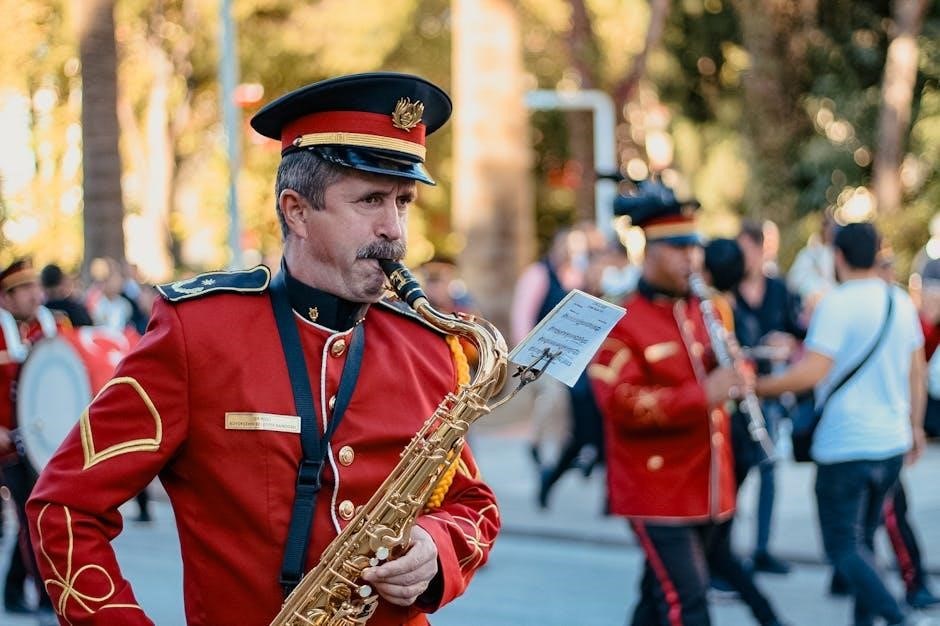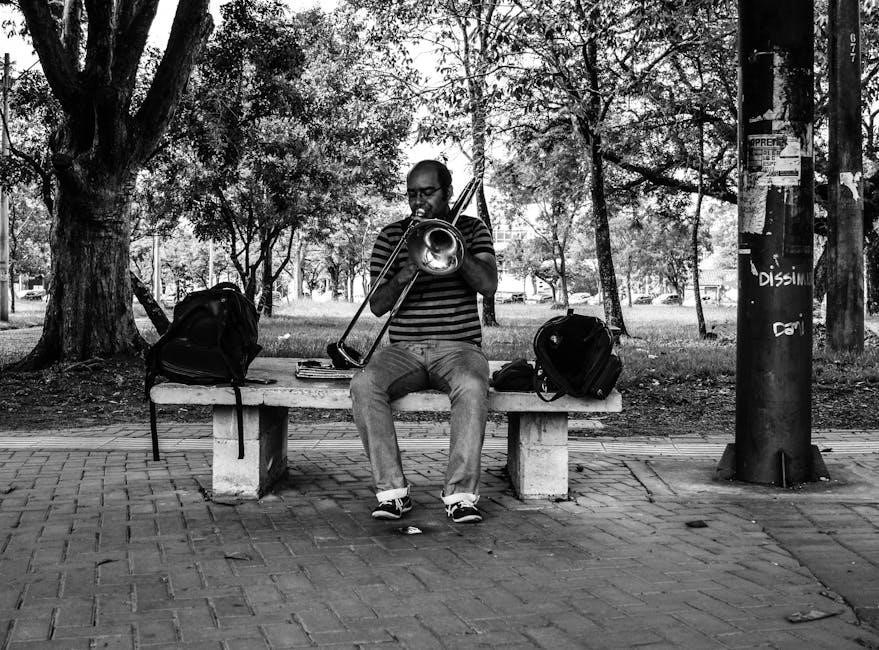
morceau symphonique trombone pdf
Alexandre Guilmant’s Morceau Symphonique is a renowned piece for trombone, showcasing lyrical and technical brilliance. Composed in 1902, it remains a cornerstone of trombone repertoire, offering deep musical expression and educational value for musicians. Available in various arrangements, including solo trombone with piano or brass quintet, it highlights the instrument’s versatility and emotional range; The piece is widely admired for its beautiful melodies and challenging passages, making it a favorite among trombonists worldwide. Its significance lies in its ability to bridge technical mastery with artistic interpretation, ensuring its enduring popularity in classical music.

Overview of the Composition
Alexandre Guilmant’s Morceau Symphonique, Op. 88, is a significant work for trombone, composed in 1902. Originally written for trombone and piano, it is marked Andante sostenuto at a tempo of 63 beats per minute. The piece is structured in two main sections, blending lyrical melodies with technical demands. It begins with a solemn, expressive theme, transitioning into a more lively and intricate Allegro movement. The composition highlights the trombone’s ability to convey both emotional depth and technical brilliance. Its availability in PDF format has made it accessible to musicians worldwide, with arrangements for brass quintet and solo trombone also popular. The work remains a cornerstone of trombone repertoire, admired for its balance of artistry and technical challenge, and is often performed in classical music settings.
Alexandre Guilmant and His Contribution to Trombone Music
Alexandre Guilmant, a French composer and organist, made significant contributions to trombone music. His Morceau Symphonique is a cornerstone of trombone repertoire, blending technical brilliance with lyrical expression.
Biographical Background of the Composer
Alexandre Guilmant, born on March 12, 1837, in Boulogne-sur-Mer, France, and passing away on March 29, 1911, in Meudon, was a distinguished French composer and organist. Renowned for his contributions to the Romantic era, Guilmant was particularly celebrated for his works for organ and chamber music. His early musical training began with his father, a local organist, leading him to develop exceptional skills as both a performer and composer. Guilmant’s connection to the trombone repertoire came through his works like Morceau Symphonique, which he composed in 1902, showcasing his ability to blend lyrical melodies with technical challenges. His compositions often reflected the French Romantic tradition, emphasizing expressive and emotive qualities. Guilmant’s legacy endures not only through his music but also as a respected educator, having taught prominent organists of his time.
Instrumental Arrangements of “Morceau Symphonique”
Morceau Symphonique is available in multiple formats, including PDF downloads for trombone and piano, and arrangements for brass quintet. It also exists as MIDI files and sheet music for various instruments.
Original Version for Trombone and Piano
The original version of Morceau Symphonique is scored for tenor trombone and piano, showcasing a rich dialogue between the two instruments. Composed by Alexandre Guilmant in 1902, it is marked Andante sostenuto at a tempo of 63 beats per minute. The trombone part is lyrical and expressive, with dynamics ranging from p con espressione to fuller climactic moments. The piano accompaniment provides harmonic support, often featuring arpeggiated patterns and chordal textures that complement the trombone’s melodic lines. The piece includes legato passages, rubato sections, and cadenzas, offering both technical and interpretive challenges. Its structure highlights the trombone’s ability to produce both powerful and delicate sounds, making it a favorite among trombonists for its balance of technique and artistry. The original version remains a foundational work in the trombone repertoire, widely performed and admired for its emotional depth and musical elegance.
Arrangements for Brass Quintet and Solo Trombone
Arrangements of Morceau Symphonique for brass quintet and solo trombone have become popular, offering a fresh perspective on Guilmant’s original composition. One notable arrangement by Jean-François Taillard adapts the piece for a brass quintet, maintaining the original’s lyrical and technical essence while expanding its harmonic and timbral possibilities. The brass quintet version features a solo trombone accompanied by two trumpets, a horn, and a tuba, creating a rich, ensemble sound. This arrangement preserves the Andante sostenuto tempo and expressive dynamics, allowing the trombone to shine as the solo instrument. The interplay between the brass quintet and the trombone adds depth and texture, making it a compelling interpretation for both performers and audiences. Such arrangements demonstrate the versatility of Guilmant’s work and its enduring appeal in diverse instrumental settings.

Performance Considerations
Performing Morceau Symphonique requires careful attention to tempo, dynamics, and phrasing. The Andante sostenuto tempo at 63 BPM demands precise control, while dynamic contrasts, from pianissimo to fortissimo, highlight the piece’s emotional depth. Trombonists must ensure fluid phrasing and breath control to maintain the lyrical flow, essential for conveying the work’s expressive qualities effectively.
Tempo and Dynamics in the Score
The Morceau Symphonique is marked Andante sostenuto at a tempo of 63 beats per minute, creating a lyrical yet deliberate pace. Dynamics range from pianissimo to fortissimo, adding dramatic contrast and emotional depth. The score emphasizes gradual crescendos and decrescendos, guiding the performer through subtle shifts in intensity. Phrasing is further shaped by articulations like legato and con espressione, enhancing the piece’s melodic flow. Trombonists must carefully balance these elements to maintain the work’s expressive qualities while adhering to Guilmant’s compositional intent. The interplay between tempo and dynamics is crucial, as it defines the overall character and ensures a cohesive interpretation of this beloved trombone repertoire staple.
Technical Challenges for Trombone Players
The Morceau Symphonique presents several technical challenges for trombonists, including sustained passages, wide intervals, and dynamic contrasts. Players must maintain a smooth, even tone across the instrument’s range while navigating intricate phrasing. The piece demands precise control over breath support and embouchure, particularly in the higher registers. Additionally, the cadenza-like sections require a strong technical foundation and expressive nuance. Trombonists must also master subtle articulations and phrasing to convey the work’s lyrical nature. The interplay between legato playing and dynamic shifts further adds to the technical demands, making this piece a true test of skill and musicality for advanced performers. Overcoming these challenges allows trombonists to fully realize the piece’s emotional depth and artistic brilliance.

Cultural and Historical Significance
Guilmant’s Morceau Symphonique is a cornerstone of trombone literature, reflecting late Romantic era musical tastes. Its composition in 1902 marks a significant contribution to the instrument’s evolving repertoire, influencing generations of trombonists and composers. The piece bridges the gap between orchestral and solo trombone music, showcasing the instrument’s expressive capabilities. Its enduring popularity highlights the trombone’s growing prominence in classical music during the early 20th century; As a staple in both performance and education, it continues to inspire musicians, solidifying its place in the cultural heritage of trombone music.

Role in Trombone Repertoire
Alexandre Guilmant’s Morceau Symphonique, Op. 88 holds a pivotal role in the trombone repertoire, being one of the most celebrated and frequently performed works for the instrument. Composed in 1902, it was written during a period when the trombone was gaining prominence as a solo instrument in classical music. The piece is admired for its lyrical melodies, technical demands, and expressive depth, making it a benchmark for trombonists to demonstrate their artistry and mastery. Its inclusion in various arrangements, such as for brass quintet and solo trombone, further underscores its versatility and enduring appeal. As a cornerstone of trombone literature, it has influenced generations of composers and performers, cementing its status as an essential work in the instrument’s historical and contemporary repertoire.
Educational Value for Musicians
Alexandre Guilmant’s Morceau Symphonique, Op. 88 is highly valued in music education for its technical and lyrical challenges, making it an essential tool for developing trombonists. The piece requires precise breath control, dynamic range, and expressive phrasing, helping musicians refine their skills. Its availability in PDF and other formats ensures accessibility for students and educators. The work also provides insight into interpretive techniques, such as nuanced articulation and tonal production, which are vital for mastering classical trombone repertoire. Additionally, studying Morceau Symphonique offers a window into late Romantic-era composition, enriching historical understanding. Its versatility in arrangements further broadens its educational applications, making it a cornerstone for both solo and ensemble training, fostering artistic and technical growth in aspiring musicians.